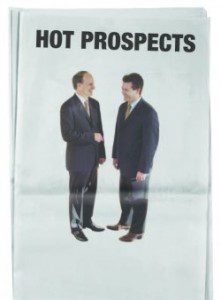Hot Prospects
The Calgary Herald has huge ambitions: to turn a minor-league paper into a major-league daily—even if it means putting up with a slew of embarrassing rookie mistakes
Except for his $250,000 grey F430 Ferrari and his equally costly Bentley Arnage, Brian Hunter kept a low profile in Calgary. The 32-year-old millionaire lived otherwise inconspicuously in one of the city’s many sprawling suburbs, waiting for his one-hectare, $3-million house to be built. Hunter traded in natural gas for a Connecticut hedge fund called Amaranth Advisors, where in 2005 Trader Monthly estimated he earned between $75 and $100 million – making him North America’s second wealthiest natural gas trader, behind only American business maverick T. Boone Pickens. In August 2006 alone, he raked in $2 billion for Amaranth. Even his friends in a recreational baseball league didn’t know about his lucrative career until he lost it all a month later.
On September 18, 2006, Amaranth sent a letter to investors saying it expected big losses as natural gas prices began to drop. On the front page of The Wall Street Journal the next day, Ann Davis reported from Calgary about Hunter’s $5 billion loss in natural gas bets. The Journal dedicated more than 2,600 words to the kid born and raised in Calgary, whom Davis had interviewed in July. The Globe and Mail picked up the Journal’s story about Hunter, as well as running one of its own. The story that appeared in the Calgary Herald, the city’s paper of record, was a Reuters business brief on page D5. It didn’t mention Hunter or that the losses were sustained in Calgary.
Two days later, the Globe reported from Calgary with interviews of Hunter’s friends and colleagues. That same day, the Herald mentioned Hunter for the first time in another Reuters article, on page D4; the Toronto Star ran the same copy. Hunter made the front page of the Herald’s Calgary Business section for the first and only time on September 28 – 10 days after the story broke. Margin Calls, a briefs section, announced Hunter had left Amaranth – a development the Globe ran on its website one day earlier. Eventually, the National Post, the Herald’s corporate bigger brother, sent John Greenwood to Calgary to profile Hunter’s demise. The article never ran in the Herald.
For the Herald to get beat, then fumble, one of the biggest business stories of the year is a journalistic embarrassment. But how it happened is part of the bigger challenge the paper faces as it struggles to match the growing influence of the city it covers. Since energy prices started breaking records in 2005, people have flocked to Alberta to cash in on the booming economy. This year, Calgary’s population surpassed one million. It’s estimated that 60 people move to the city per day and 100 immigrants from other countries relocate to Calgary per week. The boom has made the Herald one of two daily English newspapers in Canada whose circulation is actually going up. As of September 2006, its circulation cracked 120,000 on weekdays and 126,000 on Saturdays, a 7.4 per cent increase from 2002, when the Herald’s circulation bottomed out after a debilitating labour strike. The fallout meant the departure of many veteran journalists and forced management to fill the editorial roster with young prospects, leaving it a minor-league paper in a major-league city. Since then, under the leadership of current publisher Malcolm Kirk, the Herald has rebuilt its reputation as the city’s dominant paper. But what the strike took from the Herald – a generation’s worth of veteran reporters and reporting experience-prevents the paper from achieving the prominence Calgary deserves.
The Ship and Anchor Pub is a popular watering hole on the Red Mile – the strip of 17th Avenue that became infamous after the 2004 National Hockey League playoffs, when drunken debauchers in Calgary Flames jerseys made national headlines. Tonight the Ship is throwing a Halloween 1980s retro party. The young men and women who keep the city booming dance to songs by Styx and Talking Heads, written while they were toddlers. Most of Calgary’s young adults are flush with disposable income, so the shots move fast at the Ship. Beside me a suicide bomber and a hot UPS girl talk intimately. A caveman with a gun knocks a man dressed as an inflatable penis into my back.
“A lot of these people could be doing something more meaningful with their lives,” says a man at the bar who’s also being nudged by the six-foot phallus. I ask him for his thoughts on the Herald. Just before we’re toppled by a fight between a Teen Wolf and a Nacho Libre, he yells: “The reason the Herald sucks is because we don’t demand more from it.”
Calgary has always been more literate than anyone gives it credit for. The city grew out of a North West Mounted Police camp set up in 1875. A mere eight years later, the first issue of the Calgary Herald Mining and Ranch Advocate and General Advertiser appeared. With the arrival of the railway, Calgary became an important regional centre and remained the gateway to the Rockies until the discovery of large oil deposits in the province in 1947, making it a gateway to prosperity. Through booms and busts, Calgary has retained its entrepreneurial spirit, a place where anyone could yank up his bootstraps – a popular turn-of-phrase for Calgarians – and become self-made.
The Herald has not always seen eye to eye with the Cowtown it calls home. J. Patrick O’Callaghan, publisher from 1982 to 1989, believed in the old journalistic adage of afflicting the comfortable and comforting the afflicted, which some felt didn’t mesh with Calgary’s entrepreneurial spirit. When O’Callaghan left in 1989, the paper shifted to the right. In 1996, under the direction of new publisher Ken King and new owner Conrad Black, successive attempts to make the Herald a better fit with its city put management on a war footing with its own staff. Bob Bergen, a former reporter, says management’s shift led to senior editors intruding on reporters’ copy, changing their stories after-hours without consultation. As grievances about biased editing mounted, a group of staff began polling interest in unionizing.
In the fall of 1998, 62 per cent of the Herald staff voted to form a union. Once negotiations began, Bergen says the sticking point became the union’s demand for a clause allowing reporters and photographers to remove their names from stories or photos in protest. That October, Black replaced King with Dan Gaynor, who had fought unionization as publisher of The Standard in St. Catharines, Ontario. Refusing to crack, 102 Herald staffers went on strike at 3 p.m. on November 8, 1999. The battle lasted eight months, devastating everyone involved. “It ripped a big hole in friendships and ripped out hearts and hurt a lot of people,” says Don Martin, now the paper’s federal affairs columnist. Globe hockey columnist Eric Duhatschek declined an interview, but said in an email: “That was just such a difficult, challenging eight months walking that damn picket line from seven until 11 at night, five days a week, with two school-age kids and a wife who doesn’t work outside the home that I’m not all that interested in reflecting back on it; and am not sure I could offer a dispassionate analysis anyway. The wounds run pretty deep.”
In June 2000, editor Peter Menzies and Gaynor offered the remaining 93 strikers the choice of either a revamped contract or a buyout package. In the end, only eight strikers could stomach a return to the newsroom. The other 85 took the substantial buyout. For many, the decision to leave led to bigger and better things – a number are working at the Globe, former senior journalist Brian Brennan is a bestselling author, Bergen completed his PhD and is now teaching at the University of Calgary, and two strikers, Terry Inigo-Jones and Robert Driscoll, started the Alberta weekly Business Edge, which has since gone national. In contrast, the paper languished in mediocrity. Bruce Bonham, a current desk staffer, was hired immediately after the strike to work in the chaotic newsroom. Many of the replacement reporters came from community newspapers and, Bonham says, “should not have been at this level yet in their careers.” Bergen is less diplomatic, calculating that by losing 85 employees, many with more than 20 years of experience, the Herald replaced more than 1,000 years of experience with the “dregs of Canadian journalism” during the strike.
The community reached its own verdict: weekly circulation continued to decline, bottoming out in 2002 at 112,258 – a decline of 7.5 per cent.
Malcolm Kirk was 35 years old when he became editor of the Herald in 2003. A graduate of King’s College in Halifax in 1989, he had been climbing the Southam, then Hollinger, then CanWest ranks, working first for the The Gazette in Montreal and then The Province in Vancouver. In August 2006, he was installed as the Herald’s latest publisher. Wearing a blue shirt with tight, white pinstripes and perfectly pleated pants, sipping coffee in his office, he speaks eloquently of his 11 years at the Province. He thumps his cup against the table in rhythm to each position he rhymes off: “As a copy editor,” thud, “assistant sports editor,” thud, “sports editor,” thud, “news editor and managing editor,” double thud.
When he arrived in Calgary to take over the reins as editor, Kirk says he was aware the strike had affected the paper. But he also sensed a need to move on. He changed the Arts section to focus more on celebrities instead of just local arts, added a lifestyle section called Real Life, emphasized local coverage, and introduced Swerve, a Friday culture, entertainment and listings magazine that swept the Western Magazine Awards last July. “We launched just a barrage of new features,” he says, “a ton of stuff.” At the centre of most initiatives was a commitment to local coverage.
The paper suffered tough criticism, at least at first. In 2004, Robert Bragg, a former Herald reporter and columnist (now a journalism professor at Mount Royal College) who left before the strike, called the Herald’s journalism trite and forgettable in an interview with Alberta Views. “It’s an embarrassment for a city this size to have a paper this shallow, this out of touch with what’s going on,” he said. “They don’t put enough resources into it, they’re scrambling.”
But the paper’s turnaround under Kirk tells a different story. To date, weekly circulation has grown 7.4 per cent – a sign of more than just the city’s growth. Bonham says Kirk has created a positive environment in the newsroom. The awards also came. Grant Robertson won the paper’s first editorial National Newspaper Award since the strike for a story investigating the questionable business practices of the Direct Energy company in 2004. The same year, the Herald received an honourable mention from the Michener Award Foundation for public service journalism – its first since 1997. The paper won a NNA in 2005 for exposing voting irregularities in the last municipal election and was runner-up for a joint investigation with the Province that looked at abandoned Indian brides. In 2006 alone, the Herald won a total of 16 national and international newspaper awards – the most the paper has received in 15 years. Lately even Bragg is more upbeat. “You’ve started seeing more and more solid news stories,” he says. “It’s been a solid daily paper with occasional moments of brilliance and occasional lapses into really abysmal mediocrity.”
With its journalistic foundation rebuilt, Kirk now wants to capture the bootstrap spirit of the city and turn the Herald into a groundbreaking Canadian newspaper. When I ask him about what he has planned, his eyes spark with ambition – but his words are more ambiguous. Kirk repeats himself, saying that the Herald wants to lead North American newspaper journalism into the future. “Let’s see what we can do to make this the best newspaper in the city. And not just that, but beyond. Ultimately we’re going to be a multimedia news company. That’s our goal. We’re going to be able to provide you with information the way you want it, when you want it and how you want it.”
One recent change has been the online content. Editorial page editor Doug Firby introduced Q, a blog of sorts that allows readers to interact with the newspaper. Firby has also gently introduced a more sweeping change during his five years: Since he arrived in Calgary from the Standard, editorials have moved from the far right to being grounded in small-c conservative values. The paper has changed its stance on global warming – now accepting it as a reality and not sensationalist science – and in the 2004 provincial election it called for a stronger opposition to then-premier Ralph Klein. The paper does not hesitate to criticize Mayor David Bronconnier and city council on its infrastructure plans. It has vocally opposed the way the city spends taxpayers’ dollars and the state of public transit. It is increasingly proactive in suggesting alternative solutions. The Herald applauds growth, while being wary of its complications. But some observers contend that the paper can be naive. For instance, in an October 5,2006 editorial titled “Party on, folks; It’s OK,” the Herald said that despite falling oil prices, prosperity would continue to grace the province. “So, relax, Albertans. We could be better off than many Canadians for years to come.”
It is words such as these that Brian Brennan, an author of six social history books on Alberta, worries about. He says the paper doesn’t understand how the city was crushed in the ’80s. He says it has lost its institutional memory.
The grey tones in Charles Frank’s hair and his walrus moustache stand out in the Herald newsroom. He is one of precious few Herald employees with more than 20 years experience at the paper. Hired as a business writer in 1978, Frank has held numerous positions and became business editor in 2001. He brags that business stories run on A1 in the Herald more than anywhere else in Canada. The man knows his city and its millionaires: from the brutish cowboys to the quiet hedge fund traders who can lose billions in a matter of days. However, he concedes that since Calgary is removed from the major North American financial centres – New York and Toronto – the paper’s investment coverage isn’t a priority. This is one reason, Frank says, the Herald didn’t get the Brian Hunter story. By the time it broke, he says, there wasn’t much the Herald could do – though its competitors found myriad ways to cover the developments.
Current editor-in-chief Lorne Motley says the Hunter story was a one-off. “Would I have loved to have gotten that story? Sure, but every editor knows you’re going to miss some.” Like the city it covers, Motley, who’s 40, admits that the paper has a young staff compared to other major dailies. Instead of a weakness, he believes the strike was one of the key ingredients to the paper’s current success. “I wouldn’t wish it on anyone,” he says, “but the weird irony is that it has allowed us to come to where we are today.” Namely, to a place filled with aggressive journalism and creativity. In our interview, Kirk says he understands the criticisms, but argues the Herald’s reporters provide complete coverage. And he invites people to give examples of when the paper missed an important angle.
One example Brennan and others cite is the coverage of the downside of the boom: infrastructure dilemmas, labour crunches and homelessness. Though these issues are covered in the paper, Brennan says they aren’t covered with the knowledge of how such decisions can affect the city, or of just how damaging a bust can be. Don Martin sees it as a trade-off: the young staff has given the paper energy, but the lack of local historical knowledge – and the accompanying inability to put events in broader context – is a weakness. “Let’s face it, if your average reporter is 31 years old, he was six when the National Energy Program came down. I was in the process of losing my first house.”
Catherine Ford, a retired Herald columnist, agrees that youthful ambition is great, but it can take a reporter only so far. “The kind of cauldron in which young journalists learn what the city is about, learn who is important, learn what they can do and can’t do in terms of what’s the political culture, what’s management like, who can you tell to fuck off and not get fired. None of that is there.”
All critics agree that CanWest needs to give the Herald the resources to hire some of Canada’s top business journalists, just as the Post did when it launched. Calgary attracts some of the country’s most talented businesspeople, physicians and academics – but not journalists. “The Herald hasn’t managed to attract any people of that calibre,” says Brennan. “I look at the bylines in the Herald and I don’t recognize them.” Since Kirk arrived, the Herald has spent money redesigning the paper, investing in marketing and launching Swerve. Now his plan is to experiment with new ways to deliver his product. But he also claims to focus on recruiting and retaining talented columnists or reporters, despite what has already happened to some of the most promising. “The best and the brightest, if they happen to make a bit of a splash in Calgary, will be scooped up by other papers,” says Brennan. “No doubt about it.”
Brennan argues that this makes the Herald Canadian journalism’s farm team. Young and talented journalists are apt to leave the paper. A recent example is Grant Robertson, who was picked up by the Globe after winning an NNA for the Herald. This flight baffles Bonham. “I was a little bit surprised that a lot of people do seem to use it as a stepping stone,” he says, “because for me it should be a destination paper.”
In late November, two weeks after I asked Charles Frank why the Herald buried the Brian Hunter story, the paper devotes 2,500 words – beginning on page three of the business section – to the fallen trader’s tale. Two and half months after The Wall Street Journal broke the story, the article’s original reporting chronicles Hunter’s demise. But it sheds little new insight on what happened, except to say that the trader’s boss gave the 32-year-old too much power too fast and that Hunter, who declined to be interviewed, was still building his $3-million home and even contemplating heading back to work. Then, on December 31, the Herald named Hunter one of the top 10 Calgary newsmakers of 2006.
Herald hindsight had finally deemed the blown story worthy of its rightful place on the news roster.















